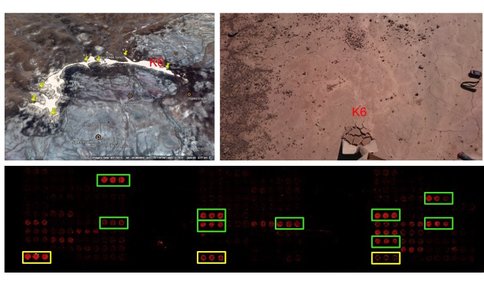2015 Annual Science Report
 SETI Institute
Reporting | JAN 2015 – DEC 2015
SETI Institute
Reporting | JAN 2015 – DEC 2015
Biomarker Profiling Using the Life Detector Chip (LDChip)
Project Summary
We have worked on the detection of molecular biomarkers in three relevant environments: Dry (Atacama), acidic (Río Tinto) and deep lake sediments (Andean lakes). Samples have been analyzed in situ by using a powerful biomarker detection chip with and antibody microarray sensor as well in the laboratory with other geomicrobiological tools.
Project Progress
By leveraging the 2015 LITA (Life In The Atacama) ASTEP project campaign a set of 90 samples was collected in Atacama desert for analysis. These samples were analyzed both in situ and in the laboratory with a immunological Life Detector Chip (LDChip), ion chromatography (IC), XRD, and biochemical extraction (in progress). In the field the LDChip detected cyanobacteria as well as other bateria and these results were confirmed in the laboratory. The IC profiles indicated the presence of anions that may be critical for certain microbial metabolisms, such as acetate and formate (electron donors) or sulfate and nitrate as electron acceptor for sulfate and nitrate reducing bacteria. The XRD analysis showed the presence of phyllosilicates as well gypsum containing samples.
In order to expand the LDChip capabilities, we have developed new antibodies to three cyanobacterial strains of the Chroococcidiopsis genus. A new collaboration with Dr. Daniela Billi (University of Rome “Tor Vergata”, Italy) provided us the biomass to use as immunogen from three Chroococcidiopsis spp., isolated from extremely arid environments: the Negev and Sinai deserts ad the Antarctic Dry Valleys. The Antibodies have been characterized individually, showing sensitivities at the level 500-1000 cells per mL. As expected, there are strong crossreactions between the Chroococcidiopsis Abs, which indicates that we have redundancy. These new antibodies strengthen the LDChip for in situ detection of cyanobacterial markers by including strains characteristics of hyper arid sites.
-
PROJECT INVESTIGATORS:
-
PROJECT MEMBERS:
Daniela Billi
Collaborator
-
RELATED OBJECTIVES:
Objective 5.3
Biochemical adaptation to extreme environments
Objective 6.1
Effects of environmental changes on microbial ecosystems
Objective 7.1
Biosignatures to be sought in Solar System materials

